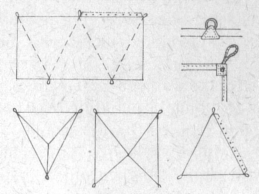Organization of a canoe camping
When planning a few-day trip to the water or a kayaking trip, we are not always aware, that the choice of a camping site is one of the most important matters. It is easier to camp in an unknown area for a small group, than for mass rafting or a numerous trip. We need to get down to business professionally to deal with our stopping place, because ill-considered location of the bivouac can be a lot of trouble. For mass tours, the selected quartermaster and the event management must take care of choosing a bivouac.
Before planning the camp, the organizers should familiarize themselves with the regulations of local authorities and obtain their consent. Then, make a reconnaissance of the area in order to most conveniently locate the future camp. We must follow the given directions.
While already in the parking area, an experienced tourist checks before setting up the tent:
1. whether the terrain is dry, sheltered from the wind (olchy, spruces, willows always herald a wet area)
2. is it even and flat
3. there is no anthill nearby
4. whether there is access to drinking water and a convenient place for bathing, sunbathing and washing. The water intake area must be above the washing and bathing area in the river, on the lake and at a distance of approx 100 m from the campsite
5. designates a camping site away from tall trees (safer during storms, rains and strong winds: lightning bolts, falling branches and drops from trees), at distance 50 m from the forest wall
6. cleans the tent place of branches, dried stalks, stones.
After choosing the place of the tent, we will only locate the direction of the entrance from the south (unless some beautiful view from the slope of a river or lake makes us change direction) and we proceed to set up the tent:
1. we take out the tent, pegs, masts with a cover
2. we unfold and stretch the tent floor, attaching it with pins
3. we fold the masts and insert them into the loosely laid shell, inserting the ends of the masts into the openings of the tent roof
4. stretch the line of the front mast and anchor, by fastening the pegs (herring) with a wooden hammer or the blunt side of the ax
5. pull the rear mast cable and tighten it well (between the masts cannot (to be "saddles."” and therefore pull the lanyards well)
6. we fasten the two front cables, and then the lines of the rear wall of the tent, and finally the side line pullers
7. because of the wind, rain (shrinkage of lines) extractors (links) we tighten it not too tightly (on the so-called. strune), to keep the tent from tearing apart,'Or tipping over at best, for the wind pulls the pegs from the ground. At night and during bad weather, loosen the links-braces a bit, to prevent the rope and tent cloth from being snatched (moisture, rain, morning dew)
8. dig a 10-15 cm wide groove around the tent, to drain the water, which flows from the tent when it rains
9. the soil from the dug groove can be used to insulate the tent, as well as protecting the floor against moisture, by covering the contact area of the tent with the ground with soil
10. having the flysheet, after its installation, we can resign from the implementation of points 8-9
11. on clear days, the windows and the entrance of the tent are open, which gives constant air circulation, and after sunset, we close the tent tightly to protect it from cooling down, moisture and mosquitoes
12. we inflate mattresses and pillows and prepare bedding for the night by arranging mattresses inside the tent with a reserve for luggage
13. we carry and fold the luggage - following the rule, that things less useful for camping should be placed as far from the entrance as possible, and food, stove, pots and toiletries closer to the entrance of the tent.
In the absence of mattresses, we can use the nearby straw, reed, they are, dry moss, and even needles, by laying them with a few centimeters of insulation layer, keeping watchful, that our "replacement mattress” was equal, soft and had a well-arranged headrest.

When we went without a tent, and we have tent sheets or some kind of waterproof sheet, after finding a place, preferably by a tree, we proceed to putting it up:
- tie the rope attached to the sharp end of the diamond to the tree
- the corners are attached to the ground with pegs (herring), hanging loops of lines on them.
If we have a homemade tent-shaped sheet and a flagpole, positioning is not difficult. In the absence of a mast, the top of the sheet must be tied with a rope to a thick branch.